25 Tips for Picky Eaters – Part 4: Succeeding at the Table
We’re armed with a master’s degree in nutrition, hundreds of hours of culinary classes, and oodles of research on parenting picky eaters.
But do you know where we put all that knowledge to the test? In our own kitchens, at our own tables, with our own kids. We’re right in the trenches with you on this one, friends, and we feel your pain!
In this five-part series, we’re sharing our top tips for navigating this tough parenting challenge. Adapt these ideas in ways that work for you and your family – the ages of your children, the ways you normally eat, and how you like to parent and teach your kids. Not every strategy will resonate with everyone – choose what’s right for you!
In week 4 of our 5-part series, we’re offering tips (#16-20) on how to serve foods in a way that encourages healthier eating habits while keeping the experience of eating and trying new foods positive for the kiddos!
16) Repetition is Your Ally (Again … and Again …)
Research has shown that repetition is the key to helping kids accept new foods. Depending on who you talk to or what study you’re reading, you’ll hear estimates that it can take as many as 10-20 tastes of a new food before a child accepts and likes that food. Ughhhhhh … this is why we’re telling you: Don’t Give Up!
17) Showcase the Options … and How Different Each Food Can Be
Have you ever considered the incredible difference between the broccoli you might remember eating in your school cafeteria (limp, army-green, mushy and kinda stinky) … and fresh broccoli dipped in ranch … or crisp-tender with bacon in a cheesy casserole … or maybe perfectly roasted and drizzled with a browned butter sauce (like the sauce we use on our green beans)?
Or how about the vast differences between a chopped raw tomato, tomato that’s been made into pizza sauce, and tomato that’s been made into French-fry-friendly ketchup?
Ok, at this point you’re picking up what we’re puttin’ down, right???
Any food can be served in ba-jillions of ways!
It’s important that you help your kids to understand that, just because they don’t care for over-cooked broccoli, it doesn’t mean that they might not enjoy broccoli with cheese sauce!
Don’t accept, “Yuck – I hate broccoli!”
Remind your kiddos that broccoli (or any other food) can be served in many ways. Help them to see these options and differences, and work together to find ways that they do enjoy eating different foods. (And remember – repetition is key!)
18) Amp Up the Nutrition … and Be Honest!
You’ve probably seen lots of strategies for hiding nutritious foods inside other foods so the kids don’t notice that they’re eating healthfully. But wait … if we’re trying to teach our little ones about the life skill of healthy eating, then we can’t really keep it a secret, can we?
At THK, we’re all about amping up the nutrition in our recipes by incorporating as many layers of veggies and other nutritious ingredients as possible. Pureeing fruits and veggies to stir some extra nutrition into a sauce or bake it into a muffin? Game on! There are great books out there that give you specific recipes to maximize this technique (and will have you spending hours preparing and freezing innumerable purees … just a heads-up!).
But here’s a problem. We just gave you a big pep talk about how important it is that your kids try new foods several times … and in several ways. That means it’s pretty critical that they actually experience the food itself – its shape, its textures, its flavors. If you’re only serving new or healthy foods in “hidden” ways, then you really aren’t getting in those all-important 10-20 exposures.
Plus, once kids realize you’ve been sneaky, they may distrust you totally. So be open and honest if those brownies are made with spinach, or the muffins have pumpkin!
And don’t forget: This is a teaching moment! We believe that our kiddos need to learn about what they’re eating and how to make nutritious choices! (Not sure what we mean? Check out Part 1.)
So yes, yes, yes! Find any way you can to pump up the nutrition content of your recipes by nestling in as many nutritious ingredients as possible! But we always recommend being honest and making sure that your menus also include plenty of opportunities for kids to experience new or questionable foods for what they really are.
19) Avoid Mysteries (and Becoming a Short-Order Cook!)
Sometimes kids can find it really difficult to be confronted by a plate of food in which everything is mysteriously jumbled together. They rightfully wonder what on earth is lurking in there and how such a mixture can possibly taste good!
Picture things like stews or stir-fries.
One route is to chop up all the veggies and other ingredients really finely, hoping that the kiddos won’t really notice what they’re eating. Usually that just ends up making your little ones hesitant about eating any of it … we don’t recommend this!
Another tactic is to make all the components nice and big, so they’re easily compartmentalized. (See last week’s post for more on this strategy.) Then kids can divide out each component (maybe separating a stew into piles of meat, potatoes and carrots) so they don’t have to decode what’s in a dish. They’re still eating the same dinner you are – they’re just eating it in a way that’s manageable for them! This helps parents avoid becoming short-order cooks who have to serve up entirely different meals for each member of the family!
Similarly, if you take a peek at our Lightning-Fast Ravioli recipe, you’ll see that the peppers, sausage, onions, ravioli and tomatoes are all in nice, big recognizable pieces. They can easily be divided into pretty piles of separate ingredients, and kids can pick out, say, the tomatoes … or the peppers … once they’ve tried a bite or two. Which brings us to our next point …
20) Establish a “No-Thank-You-Bite” Policy
You’ve probably heard of a “one-bite” or “no-thank-you” rule. It pretty much means that kids (or a picky husband!) are expected to take at least one or two bites of each food on the plate. Then, they’re free to say “no thank you” to that food and move on to enjoy other parts of the meal they like better. (Or maybe after the first bite they’ll decide they want to take a second bite … and a third!)
This sets kids’ expectations: they know they have to try everything (which helps them toward that goal of 10-20 exposures), but they can also relax in knowing that they can then eat the foods they like most for the rest of the meal.
Added bonus: In addition to raising good eaters, we’re also working on raising polite kids! “No thank you” is just plain good manners!
Want more tips to help your kids become better eaters? Check out:
- Part 1: Getting Started
- Part 2: Getting the Kids Involved
- Part 3: It’s All About the Marketing
- Part 5: Don’t Make It a Battle
Disclaimer: These tips are just suggestions and may not be right for each child or each family. If you have concerns about your child’s eating habits or questions about nutrition, check with your pediatrician or a licensed dietician who’s familiar with your child’s specific needs.

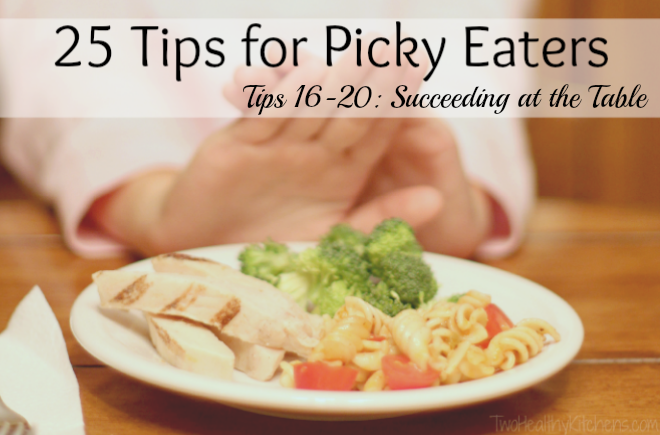
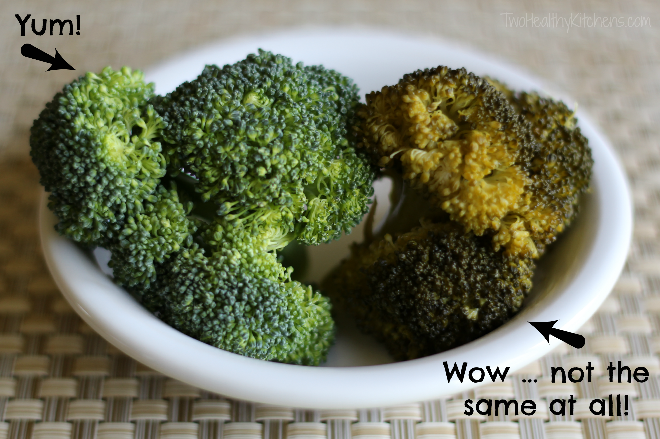
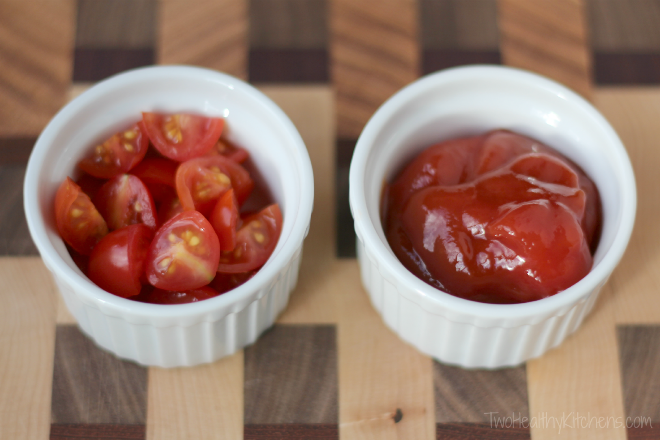


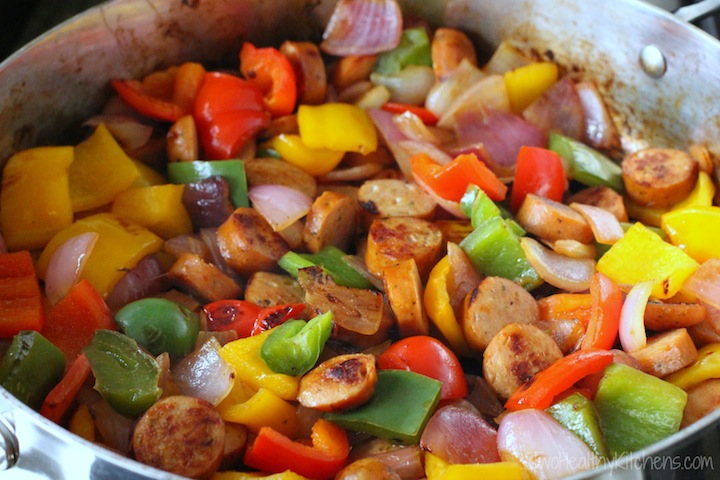
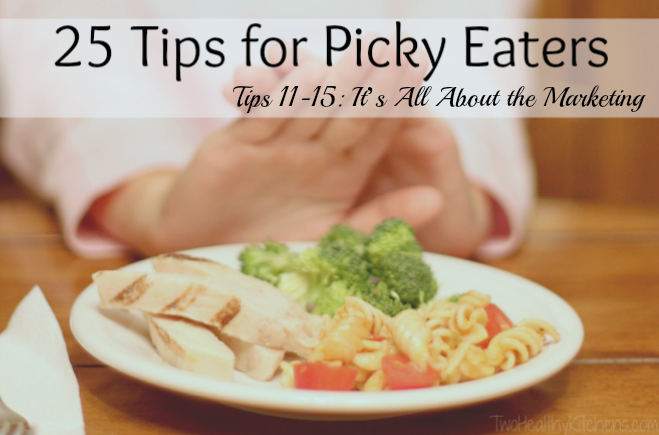
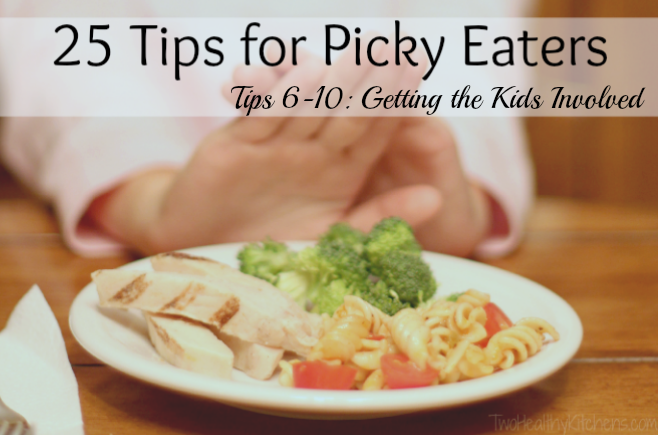
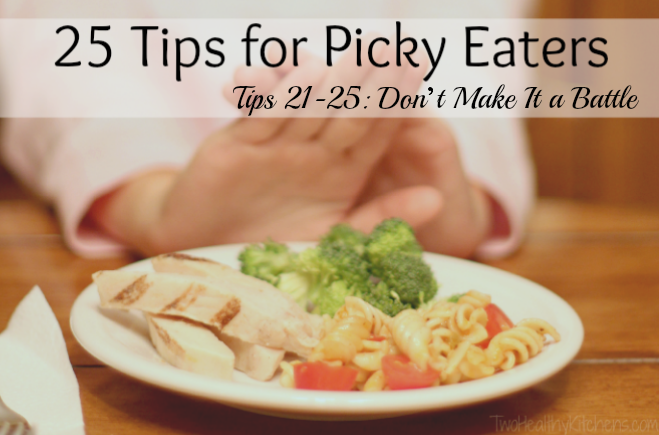
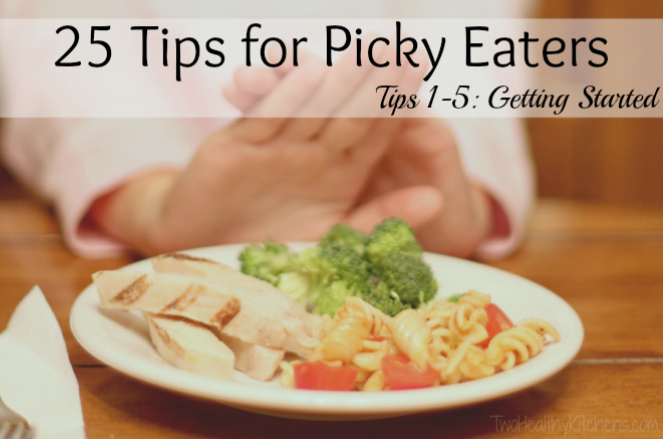
Absolutely Wonderful Tips!! I love all of these. I always say presentation matters whether it is for an adult or a child. When food looks good it is so much easier to get them to eat it. My kids do not like when everything is mixed together i.e. casseroles. They become detectives and want to dissect the entire dish. You can only imagine how awful that is to watch. To make it a little easier I will leave some of the ingredients separate so they still eat what we eat but they way they like it. I find that they eventually want it served like everyone else.
I must say, I commend you ladies on these tips! I’m sure it is no small feat organizing such important information. Well Done!! 😀
My daughter is a “casserole detective” too! I learned that food was so much more approachable for her if she could just identify the individual components. And you’re right! As she’s gotten older, she’s getting much less concerned about her foods touching and about things being all jumbled together! It really is a process, though, huh?!? But worth it, for sure! She’s becoming so aware of her food choices and makes lots of fantastic eating decisions – I feel like all my efforts in helping my kiddos become good eaters are really starting to pay off! Thanks so much for the kind words, Cindy! Especially coming from someone like you who does such wonderful tutorials filled with great healthy eating info, it’s really high praise and so much appreciated! 😀 ~Shelley